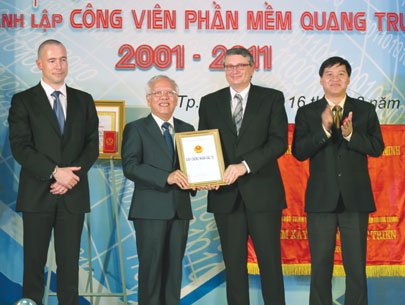 Developing software parks proves to be an important task in order to turn Vietnam into an information technology (IT) power. However, it is not an easy mission.
Developing software parks proves to be an important task in order to turn Vietnam into an information technology (IT) power. However, it is not an easy mission.The software parks remain bad at two things 1/ acting as intermediaries to create favorable conditions for big enterprises to develop in international links and 2/ acting as nursery gardens that help create groups of small enterprises targeting technology services.
Vietnam now has 20 software parks, including the approved but project that have yet to be constructed. However, very few software parks have been operating successfully. Despite many incentives from the government, other parks are still busy looking for direction and their role in the IT development remains very dim.
To date, considering the infrastructure conditions and the capability to attract investors, the Quang Trung Software Park is considered the most successful park.
Speaking at the ceremony held on the occasion of the 10th anniversary of the software park, Deputy Prime Minister Nguyen Thien Nhan said that Vietnam will continue developing software parks across the nation in the next 10 years and the new parks will learn lessons from Quang Trung park’s operation in the last 10 years.
The key lesson of Quang Trung: giving autonomy to developer
Established in 2011, in the first phase of operation, Quang Trung only attracted 21 enterprises and 250 workers. To date, the number of enterprises has increased to 101, including 43 foreign and 58 domestic enterprises, while 22,800 workers are working and learning there. The total registered business capital is 78.83 million dollars.
In order to obtain the results, right since the first day of operation, Quang Trung was given autonomy by the HCM City People’s Committee, allowing it to run a concentrated management mechanism.
Chu Tien Dung, Chair of Quang Trung Software Park Development Company said that most software parks have been programmed in accordance with the state’s management, while the State has spent money to build infrastructure items.
Therefore, they have been meeting difficulties with its administration and calling for investment.
Meanwhile, as for Quang Trung, the HCM City’s authorities decided to apply a concentrated management mechanism and assigned tasks to Quang Trung, instead of setting up a management board like the ones existing in other concentrated technology zones.
The city’s authorities also “bravely” allocated investment capital to Quang Trung and told it to attract investment from private investors.
To date, the State has spent only 200 billion dong out of the total 1800 billion dong worth of capital. As such, each and every dong of the state’s investment could attract eight dong worth of investment capital from other sources.
According to Dung, the decision by the HCM City’s authorities to grant the autonomy to the developer has helped Quang Trung do a lot of things right in its first stage of development.
However, though being considered a success story, Dung said Quang Trung is facing many big challenges, especially the competition raised by the establishment of new software parks.
Therefore, Quang Trung expects to have a new, more flexible management model. It has asked the city’s authorities to allow turning Quang Trung Development Company into a holding company which it believes will be able to optimize the capital mobilization and muster strength.
Development of software parks needs thorough consideration
A recent survey conducted by the Information and Communication Strategy Institute shows that the role of software parks remains dim, and the parks still cannot make generate turnovers and make big contributions to technology development.
The software parks remain bad at two things 1/ acting as intermediaries to create favorable conditions for big enterprises to develop in international links and 2/ acting as nursery gardens that help create groups of small enterprises targeting technology services.
In neighboring countries such as China, Malaysia and Thailand, software parks have been playing a very important role in the economies.
In China, Zhongguancun Science Park, the biggest hi-tech zone in the country, has attracted 20,000 companies, 60 percent of which are IT companies. Besides, it has attracted 58 universities and 232 research institutes.
Experts have pointed out that Vietnam needs to thoroughly consider all facotrs when deciding to develop software parks.
In fact, the number of software parks in other regional countries is not high: Thailand has five, South Korea four and Japan seven.
Most of the parks are located on advantageous positions, while their investment capital comes from many sources – the state, foreign companies and domestic investors.
Most of the parks now account for big proportions in the turnovers of the countries’ IT industry.

 Previous page
Previous page Back to top
Back to top







